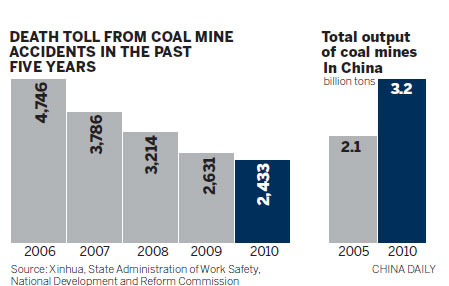Spokesman and chief engineer for the State Administration of Work Safety, Huang Yi, said in a news conference by the State Council's information office on Friday that 2,433 people died in coal mine accidents in China last year, 198 fewer than in 2009.
The figure represents an average daily death toll of more than six people.
However, the declining death toll, a 7.5-percent drop, highlights improving underground conditions amid an upgrade in safety and management, he said.
 cription="编辑提供的本地文件" sourcename="本地文件" style="width: 449px; height: 286px" />
cription="编辑提供的本地文件" sourcename="本地文件" style="width: 449px; height: 286px" />
The number of coal mine accidents in 2010 also declined 13.2 percent year-on-year, the spokesman said.
According to earlier Xinhua reports, citing safety and mine officials, 4,746 people died in mine accidents in 2006; 3,786 in 2007; 3,214 in 2008 and 2,631 in 2009.
Huang said his administration closed 21,200 illegal coal mines and slashed the number of small-scale mining operations from 18,145 to 9,042 over the past five years.
The administration also oversaw a major reduction of gas levels in the mines, he said.
Moreover, Huang added, the administration will issue standards for the use of facilities in shelters, which must be built in all mines over the next three years.
"The fatality rate per million tons of coal produced decreased 73 percent in the past five years and it will further fall 28 percent over the next five years," Huang said.
Huang told China Daily the administration set the compulsory target because coal mine safety remains "the priority of priorities".
He added China can meet safety targets and "the achievement will lay a critical foundation for China to turn around its work-safety status by 2020, when safety levels will equal that of moderately developed countries".
However, Huang said challenges remain. The safety culture has not taken root and many mines ignore or pay little attention to it, he said.
China's total coal production has risen from 2.1 billion tons in 2005 to 3.2 billion tons in 2010, when it reached 45 percent of the world's total output, Director of the National Development and Reform Commission Zhang Ping said in January.
High fatality rates have plagued the industry.
Deaths per million tons of coal extracted are 30 to 50 times that of developed countries, Fang Junshi, head of the National Energy Administration's coal department said in September 2009.
Some critics even suspect the credibility of the fatality statistics, alleging lax regulation, corruption and officials' liability for accidents often result in underreporting of deaths.
After a mine explosion in Mianchi county, Henan province, in December 2010, police investigations found four bodies were deliberately hidden in the mine and seven suspects colluded to underreport nine other bodies.
The administration also vowed that one of its key tasks in 2011 is to tighten investigation procedures and severely punish those who cover up accidents, lie or delay their reports.
A total of 79,552 people died in 363,383 accidents in the country last year.
The number of fatalities was 4.4 percent down on 2009 figures and the accident rate was 4.2 percent lower, the administration reported.


![经典常用英语口语500句[收藏]](https://www.yingyuw.cn/file/upload/202110/06/230235911.png)




